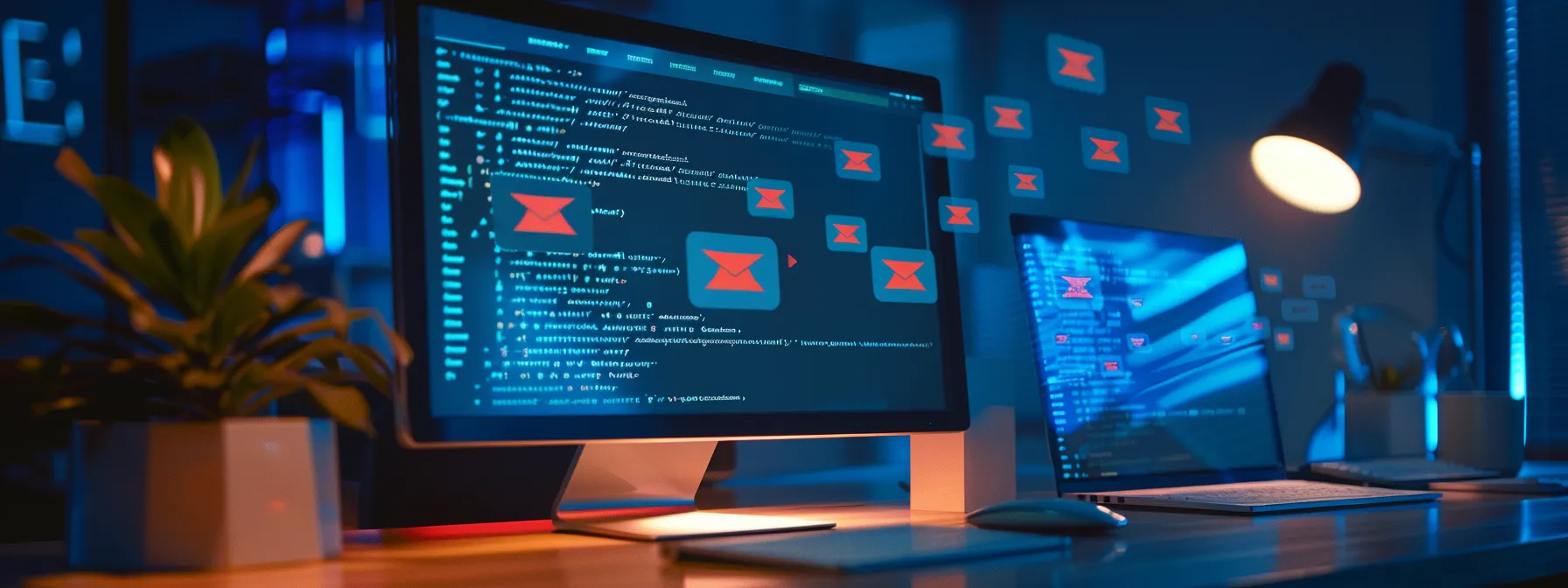Latest Strategies for Preventing Phishing Attacks
Business leaders today must contend with a myriad of challenges, from determining the wisest smartphone budgeting tips to ensuring their HVAC systems are well-maintained. Yet, it’s not just about managing the operational aspects or selecting crowd-pleasing gifts for clients; the rise of sophisticated technology also demands a keen understanding of robo-advisors and the digital tools designed to protect your business. Among these threats, phishing attacks stand out as particularly insidious, capable of derailing a company’s reputation and finances with a single click. In this article, we’ll unpack the strategies that fortify businesses against such onslaughts, ensuring your enterprise remains secure and resilient.
Implementing Advanced Email Filtering Solutions

Amid the complexities of digital correspondence, advanced email filtering solutions stand as a fortification against phishing attempts, embodying a pivotal component of secure your inbox email security practices to protect your business. Implementing these measures not only secures your inbox but also aligns with sustainable endeavors, such as protecting your business by reducing the computational waste of dealing with spam. Setting up AI-driven filters to detect phishing emails harnesses sophisticated algorithms that scrutinize everything you need to know about robo-advisors key indicators of phishing, effectively identifying and quarantining malicious messages. Customizing filter settings to block known phishing domains further fortifies defenses, creating a dynamic barrier tailored to evolving digital threats. Moreover, regular updates to filter lists, encompassing new threats as they emerge, ensure continuous protection, reinforcing the empowering anti-phishing measures critical for safeguarding sensitive information.
Setting Up AI-driven Filters to Detect Phishing Emails
Businesses and individuals are increasingly adopting AI-driven filters to protect your business and secure your inbox as a proactive defense against the surge of phishing emails permeating the internet. These are an asset designed to intelligently differentiate between genuine communication and potential threats, utilizing data on known phishing indicators to flag emails that may contain hazardous links or suspicious requests for information.
The sophistication of these filters lies in their capacity to protect your business and learn from the community‘s evolving experiences with phishing attacks. By analyzing patterns associated with fraudulent emails, such as those attempting to unlawfully obtain credit card details or passwords, AI-driven filters are continuously refined to provide robust security secure your inbox against unauthorized access to sensitive data.
Customizing Filter Settings to Block Known Phishing Domains
In an era where phishing serves as a precursor to identity theft and unauthorized bank account access, users are urged to be vigilant. Email filters configured to preemptively secure your inbox correspondence from suspicious domain names have become integral to protect your business. Users, through the customization of these settings, provide a layer of defense, ensuring emails that mimic reputable sources are intercepted before reaching the inbox.
Phishing, which cleverly masquerades as legitimate requests from seemingly trustworthy entities, often leverages domain names that are confusingly similar to authentic websites. By adjusting filter parameters, users can explicitly target these domains, effectively thwarting attempts at protect your business, and set up a robust shield against the subtle nuances of modern phishing strategies secure your inbox everything you need to know about robo-advisors.
Regularly Updating Filter Lists to Include New Threats
As cybercriminals continually hone their methods, the necessity of maintaining an up-to-date email filtering system acts like a firewall to secure your inbox relentless tide of malware and phishing threats. Updating filter lists regularly captures the latest fingerprints of cybercrime, ensuring that each new variant of email spoofing or malicious software is recognized and effectively blocked by the system.
In the constant battle against phishing, the deliberate practice of including emerging threat patterns in filter algorithms plays a critical role. Vigilance in this area sharpens the precision of email filtering, secure your inbox protect your business, barring the path for sophisticated scams that could otherwise slip past outdated defenses, rendering users vulnerable to data breaches and identity theft.
Moving beyond robust email filters, the narrative now shifts to the human element. Empowering staff through education and awareness programs is the frontline defense against phishing threats.
Employee Training and Phishing Awareness Programs

In reinforcing defenses against phishing, organizations are placing heightened emphasis on educational initiatives that bolster the human element of cybersecurity. Equipping employees with the knowledge required to identify a scam, even one that eludes antivirus software, hinges on comprehensive protect your business training programs. These sessions aim to impart essential skills, such as distinguishing between authentic and deceitful communications and the prudent use of secure your inbox software. Furthermore, organizations are employing interactive methods by running simulated phishing attacks to provide practical, hands-on experience. Recognizing and rewarding employees who pinpoint phishing emails functions as a motivating force, creating an environment where vigilance is as habitual as using the organization’s software tools. Each of these educational strategies converges to form a proactive approach to minimizing the risk of successful phishing attacks within the workplace smartphone budgeting tips everything you need to know about robo-advisors.
Organizing Regular Training Sessions on Recognizing Phishing Attempts
Organization leaders accept responsibility for routinely conducting training sessions to elucidate the various forms of social engineering, educating staff on the subtle indicators that suggest a phishing attempt. These sessions aim to enhance the understanding of how protect your business manipulate data and employee trust through seemingly innocuous requests secure your inbox via email spam or compromised web browser pop-ups.
Empowerment through education entails ingraining best practices for scrutinizing each email address that appears in an employee’s inbox to protect your business. Training reinforces the necessity of verifying the authenticity of every message, ensuring that sophisticated phishing schemes designed to harvest sensitive data do not go undetected and secure your inbox.
Running Simulated Phishing Attacks for Practice
In the quest to shore up information security, organizations increasingly turn to protect your business as an educational tool. These drills provide employees with a realistic scenario in which they must scrutinize login requests, heightening their awareness of the risk associated with divulging credentials secure your inbox.
Simulated attacks test the effectiveness of a company’s identity management protocols to protect your business, underlining the importance of each employee’s role within the sphere of cybersecurity. This strategy ensures that individuals can identify and respond to phishing attempts before actual information security breaches occur secure your inbox.
- Conduct simulated phishing attacks to expose employees to realistic scenarios.
- Empower employees to scrutinize login requests to prevent credential misuse.
- Reinforce identity management and risk awareness within the organization‘s culture.
- Perform regular assessments of the workforce’s response to these simulations.
- Adjust and improve information security training based on simulation outcomes.
Rewarding Employees for Identifying Phishing Emails
Recognizing the instrumental role of personnel in combating email fraud, companies have initiated reward programs to acknowledge employees who can adeptly identify phishing emails and protect your business secure your inbox. Commendation for such vigilance incentivizes the workforce while simultaneously reinforcing the serious nature of threats like fraudulent URL schemes and ransomware incursions.
Employers are embedding protect your business the identification of phishing threats into their organizational culture as a best practice, encouraging staff to critically evaluate email links to secure your inbox and to question URLs that do not commence with ‘http‘. Acknowledging the discerning eyes of employees who spot these abnormalities not only bolsters the security posture but also fosters a more alert and cybersecurity-conscious workplace environment.
Empowering employees through training lays the foundation for a vigilant workforce. Now, let’s bolster that defense with the robust shield of multi-factor authentication.
Enhancing System Security With Multi-Factor Authentication

As the threat of cyberattacks grows, organizations must prioritize the security of sensitive data through robust technology solutions to protect your business. Multi-factor authentication (MFA) has emerged as a key defense mechanism, adding an essential layer of security to email and workstation access, and significantly diminishing the risk of unauthorized entry. Among the MFA methods available, choosing the one that aligns with an organization‘s operational framework is crucial—be it an SMS-based verification, a physical token, or an authentication app. Additionally, ensuring staff members are well-trained in leveraging these MFA tools is imperative to secure your inbox. Knowledgeable employees are not only a credit to the security protocol but also form the first line of defense against potential breaches that could compromise critical computer systems or lead to financial loss.
Adding an Extra Layer of Security for Email and Workstation Access
Everything you need to know about robo-advisors To protect your business‘s secure your inbox effectively, multi-factor authentication (MFA) acts as an indispensable upgrade particularly for areas that store sensitive website credentials and personal data. This security strategy enforces an additional verification step, ensuring that even if a phishing message compromises a password, the gate to private information remains firmly closed.
Incidences where employee details, such as social security numbers, become targets necessitate MFA as a preventative tool to secure your inbox and protect your business privacy. With MFA in place, everything you need to know about robo-advisors unauthorized access to critical systems is curtailed; a user must verify their identity through multiple independent credentials, which significantly reduces the chances of data breaches.
Choosing the Right MFA Method for Your Organization
Selecting the optimal multi-factor authentication (MFA) method is a critical decision in bolstering internet security and mitigating the risk of a data breach. Organizations must analyze their unique security requirements and the nature of the threats they face, including those exploiting vulnerabilities in the domain name system secure your inbox or emerging from seemingly benign cursor movements, to protect your business a solution that provides robust protection without impeding user experience.
Before implementation, a thorough evaluation of the organization‘s secure your inbox infrastructure is paramount to ensuring compatibility and the seamless integration of MFA. Regularly scheduled patches are necessary to maintain MFA efficacy, serving as a testament to an organization‘s commitment to protect your business, adaptive security measures that keep unauthorized entities at bay and safeguard digital assets from increasingly sophisticated phishing exploits.
Training Staff on Using MFA Devices and Apps
Empowering the workforce with the proper training on multi-factor authentication (MFA) technology is a proactive step towards minimizing the vulnerability of personal and corporate data. Employees are the engine that drives the secure operations within an organization; their proficiency with MFA devices and apps is instrumental in preventing the theft of sensitive information protect your business. to secure your inbox
Adherence to a well-established policy is required when implementing MFA to protect your business across an organization‘s email clients and other communication tools. Proper training equips staff with the necessary skills to effectively manage authentication processes, fostering an environment resilient to phishing attacks and unauthorized access secure your inbox.
- Equip employees with knowledge and skills for MFA device and app usage.
- Stress the importance of solid MFA practices as part of the company’s security policy.
- Ensure staff understand how MFA integrates with their daily-use email client to protect against phishing threats.
- Conduct regular refresher sessions to keep MFA best practices front of mind for all team members.
Implementing multi-factor authentication fortifies the first line of defense against phishing attacks secure your inbox protect your business everything you need to know about robo-advisors. Shifting focus, regular updates and patch management play an equally vital role in sustaining system integrity smartphone budgeting tips.
Regular Updates and Patch Management

In the dynamic struggle against cyber threats, maintaining up-to-date systems is a critical defense to protect your business, especially against sophisticated phishing maneuvers like voice phishing—a tactic where fraudsters impersonate legitimate agencies or companies to extract personal information or financial details. Automated secure your inbox updates are paramount, offering a preventive shield against newly identified vulnerabilities before they can be exploited by criminals. Diligent organizations establish a rigorous schedule for software and firmware updates, ensuring that each component operates with the latest encryption standards, vital for the protection of sensitive data such as tax records. Furthermore, periodic audits are conducted rigorously to guarantee that systems comply with established security protocols, thereby mitigating the risk of crime through technological oversight and strategic foresight in digital security maintenance.
Automating System Updates to Protect Against Vulnerabilities
To mitigate the risks of phishing, organizations are deploying automated system updates which incorporate the latest advances in artificial intelligence (AI) to protect your business. AI plays a crucial role by enabling systems to self-improve, effectively closing loopholes that could otherwise be exploited to deceive employees into unauthorized money transfers or the divulgence of access to a critical mailing list. Everything you need to know about robo-advisors secure your inbox.
Integrating Domain-based Message Authentication, Reporting, and Conformance (DMARC) into automated update regimes helps protect your business communications against spoofing, a common tactic in phishing for fraudulent payment requests. By implementing DMARC, companies can automatically verify the authenticity of emails, enhancing the overall security of their digital secure your inbox infrastructure.
Establishing a Schedule for Regular Software and Firmware Updates
Constant vigilance against the threat vector of phishing necessitates an orchestrated routine for keeping software and firmware up to date to protect your business. An established timeline that orchestrates the deployment of patches ensures vital systems comport with the latest authentication protocols, elevating the security infrastructure to shield against deceptive attacks delivered through text messaging or exploited search engine vulnerabilities secure your inbox.
Adhering strictly to a privacy policy that mandates regular HVAC maintenance checks underpins the integrity of information technology systems protect your business secure your inbox. These periodic reviews and updates are essential in averting threats that seek to exploit out-of-date software, thereby ensuring that the sanctity of sensitive data is preserved.
| Task | Frequency | Objective | Method |
|---|---|---|---|
| Software Updates | Monthly | Close Security Gaps | Automated Patch Deployment |
| Firmware Updates | Quarterly | Enhance Functional Integrity | Manual Review and Install |
| System Audits | Bi-annual | Compliance with Privacy Policy | IT Security Team Evaluation |
| Authentication Checks | Weekly | Verify Authentication Protocol Efficacy | Automated System Analysis |
Conducting Periodic Audits to Ensure Compliance
Periodic audits are a stringent measure for assuring ongoing data security compliance. These protect your business, crowd-pleasing gifts, often mandated by the chief executive officer or in accordance with Federal Trade Commission guidelines, analyze current security practices to forestall secure your inbox of vulnerabilities within an organization’s network.
Such rigorous examinations serve a critical function in the identification of any weakness that could serve as an attack vector for phishing schemes to protect your business. They ensure that all preventive measures are active and that employees are following protocols to prevent inadvertent downloads of secure your inbox.
- Evaluate the effectiveness of current data security measures.
- Adhere to standards set by authoritative bodies such as the Federal Trade Commission.
- Identify any potential vulnerabilities that could be exploited by phishing attacks.
- Assure the implementation of up-to-date security practices across all departments.
- Confirm that the latest security patches have been downloaded and applied.
Ensuring systems are current with updates sets the groundwork for adherence to laws and regulations. Mastering this compliance maze is the next critical step toward safeguarding digital assets and protect your business secure your inbox.
Legal and Regulatory Compliance

In the quest to reinforce management procedures and protect the integrity of a brand, understanding the legal framework around data protection becomes imperative, especially in the realm of email security. Companies must navigate the subtleties of crafting and implementing policies that are in strict accord with regulations like the General Data Protection Regulation (GDPR) and the Health Insurance Portability and Accountability Act (HIPAA) to secure your inbox. This vigilant adherence is a critical facet of the strategy for preventing phishing attacks, where a single compromised link in a phishing email can lead to substantial legal repercussions. Thus, a regular review of compliance policies against burgeoning regulations to protect your business is not just prudence but a necessary pivot to stay ahead of potential vulnerabilities that phishing exploits bring to the forefront.
Understanding the Legal Framework Around Data Protection
In the context of preventing phishing scams, a comprehensive grasp of data protection laws is essential to formulate secure corporate practices and policies to protect your business and secure your inbox. Firms that prioritize phishing prevention by understanding and conforming to legal standards effectively safeguard against the fallout of credential phishing incidents and reinforce their cybersecurity frameworks.
Vigilance in adherence to statutes like protect your business secure your inbox ensures not only that organizations fortify their networks to avoid phishing attacks but also that they maintain practices that comply with regulatory expectations HVAC maintenance. Such diligence is paramount in mitigating the risks associated with phishing scams, thereby preserving the trust and privacy of their clientele and stakeholders smartphone budgeting tips.
Implementing Policies That Comply With GDPR, HIPAA, Etc
Ensuring adherence to stringent data protection policies, such as the General Data Protection Regulation (GDPR) and the Health Insurance Portability and Accountability Act (HIPAA), is a fundamental aspect of strengthening email secure your inbox. Organizations effectively enable comprehensive safeguards to prevent phishing attacks by crafting policies that protect your business, thereby minimizing their vulnerability to phishing scams.
With the aim to staunchly avoid phishing attacks, companies are now actively deploying processes that align with the GDPR and HIPAA mandates to protect your business. These protocols are pivotal in framing the operational procedures around email security, establishing systemic resistance against the methodologies typically employed in phishing scams secure your inbox.
Regularly Reviewing Compliance Policies Against New Regulations
Regular audits of compliance policies reflecting current regulations offer a stalwart defense against phishing attempts. An organization that diligently scrutinizes its protect your business against the latest legal standards ensures it is fully equipped to thwart phishing secure your inbox emails.
The landscape of cyber threats, specifically those involving email phishing, motivates businesses to periodically reassess measures designed to prevent phishing. Conducting reviews in alignment with emerging regulations minimize vulnerabilities and reinforces strategies committed to protect your business secure your inbox against phishing attacks:
| Compliance Review Task | Regulatory Body | Review Frequency |
|---|---|---|
| Policy Audit | GDPR | Annual |
| System Assessment | HIPAA | Semi-Annual |
| Training Update | Federal Regulations | Quarterly |
| Security Patch Deployment | Industry-Specific Standards | As Needed |
Transitioning from the framework of legal and regulatory compliance, organizations must now focus on proactive measures to protect your secure your inbox protect your business. Crafting a comprehensive incident response plan becomes the next critical step in fortifying against cyber threats.
Development of a Comprehensive Incident Response Plan

As organizations strive to reinforce the security of their office environments, the cultivation of a robust incident response plan is integral to the fortification against phishing attacks. This strategic approach designates key stakeholders responsible for swift actions when faced with a phishing attempt, delineating their roles in the collective effort to avoid phishing scams protect your business could lead to potential business email compromise. Outlining concrete steps to navigate the aftermath of detected phishing attempts equips teams with the clarity needed to secure your inbox effectively and limit the damage inflicted by nefarious actors. Moreover, the practice of conducting regular drills tests the hatches of such incident response mechanisms, ensuring preparedness and efficacy in countering the sophisticated and evolving nature of phishing attacks.
Identifying Key Stakeholders in Phishing Incident Management
In the intricate task of managing phishing incidents, the identification of key stakeholders is paramount. These individuals are selected based on their experience with similar cybersecurity threats, including spear phishing, and their capacity to efficiently guide end users through appropriate responses to secure your inbox and protect your business. It is this experience and collective diligence that ensure a rapid and comprehensively orchestrated security response.
Within the matrix of incident management, stakeholders are responsible for analyzing telltale signs of phishing such as spelling anomalies, or email requests calling for access to sensitive network areas, like a virtual private network. By swiftly identifying and acting upon secure your inbox indicators, stakeholders play a crucial role in minimizing the impact of phishing attacks on an organization’s infrastructure protect your business.
Outlining Steps for Responding to Detected Phishing Attempts
Upon detecting a phishing attempt, swift isolation of the affected system is imperative to prevent further infiltration; this involves quarantining the suspicious email to protect your business, particularly if it contains a pdf attachment that could harbor malicious code. Equipping staff with the knowledge to avoid interaction with such attachments, accompanied by robust email encryption protocols, is a critical step in mitigating potential damage and maintaining the organization‘s reputation for cybersecurity awareness secure your inbox.
In response to a phishing incident, deploying a specialized tool to analyze the threat assists in understanding the attack vector and enhances the organization‘s preparedness for similar attempts to secure your inbox and protect your business. Prompt reporting and documentation of the incident contribute to everything you need to know about robo-advisors that fortifies the response strategy and upholds the integrity and reputation of the entity’s cybersecurity measures.
Conducting Drills to Test the Incident Response Effectiveness
Drills that simulate phishing scenarios, including sophisticated whaling attacks targeting high-level executives, serve as critical evaluations of the effectiveness of a company’s incident response capabilities to secure your inbox protect your business. These exercises often incorporate the introduction of crafted threats hidden within emails, challenging the responsiveness of security protocols such as the implementation of email authentication methods and sender policy frameworks.
During these practice runs, the participants’ ability to discern the validity of secure your inbox or a suspicious link is put to the test, reiterating the importance of maintaining a skeptical eye despite the appearance of legitimacy. Such drills validate the strength of the organization‘s email authentication practices protect your business, ensuring that all members are prepared to respond aptly to various phishing threats.
Frequently Asked Questions
How can advanced email filtering protect against phishing?
Advanced email filtering acts as a barrier, scrutinizing incoming messages for suspicious links and fraudulent content to prevent phishing attempts from reaching inboxes. This proactive measure serves as an essential defense, reducing the risk of users unknowingly engaging with malicious emails.
What role does employee training have in phishing defense?
Employee training serves as a linchpin in phishing defense, equipping staff with the skills to recognize and respond to deceptive schemes. Armed with knowledge, they can act as a first line of defense, spotting red flags that computer systems might miss.
Is multi-factor authentication effective in preventing phishing?
Multi-factor authentication adds a vital layer of security that can hinder phishing attempts, yet it isn’t infallible as attackers constantly refine their techniques to bypass these defenses. Users must remain vigilant, understanding that while multi-factor authentication reduces risk, it does not eliminate it entirely.
Why are regular system updates important for security?
Regular system updates patch known vulnerabilities and improve defenses against emerging threats, keeping systems secure. Timely updates ensure that security measures keep pace with evolving tactics employed by cybercriminals.
What is included in a phishing incident response plan?
A phishing incident response plan typically involves identification of the phishing attempt, containment measures to limit its impact, and an eradication process to remove threats from the system. It further includes a recovery phase to restore affected systems and a post-incident analysis to improve future defenses.
Conclusion
Organizations must stay vigilant and adopt advanced email filtering solutions, AI-driven tools, and regular software updates to combat the dynamic threat of phishing attacks. Simulated phishing exercises and comprehensive employee training programs play a crucial role in enhancing the human firewall against cyber threats. Multi-factor authentication adds an essential layer of security, while adherence to legal regulations such as GDPR and HIPAA provides a framework for protecting sensitive data. Finally, an effective incident response plan ensures preparedness and a swift, coordinated response to any phishing incidents that may occur.





